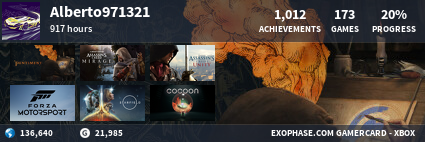Confronto molto interessante fatto con i due principali competitor sul mercato:
The specs (winner in red):
Screens (clear win. Most people can't render 144hz, for most 120hz is plenty and IMHO OLED trumps all. HDR is gravy on top):
PSVR2: 2000 x 2040 per eye. OLED with HDR. Up to 120hz refresh rate.
Valve Index: 1600 x 1440 per eye. LCD. Up to 120hz refresh rate (144hz experimental)
Quest 2: 1832 x 1920 per eye. LCD. Up to 120Hz refresh rate.
Lenses (clear win):
PSVR2: 110 degrees field of view. Fresnel lenses. IPD settings Unknown.
Valve Index: 130 degrees field of view. Fresnel lenses. IPD settings 58-70.
Quest 2: 110 degrees field of view. Fresnel lenses. IPD settings 58, 63 or 68.
Tracking (win debatable. External sensors provide better tracking, but might not be practical unless you have a dedicated vr room):
PSVR2: Inside out tracking via 4 cameras in the headset. No external sensors needed. Controllers only tracked when in view of headset cameras.
Valve Index: 2 external sensors needed for tracking of headset and controllers.
Quest 2: Inside out tracking via 4 cameras in the headset. No external sensors needed. Controllers only tracked when in view of headset cameras.
Eye tracking (clear win):
PSVR2: Cameras inside the headset tracking your eye movement. Not confirmed whether the eye tracking is paired with foveated rendering or these features are separate.
Valve Index: None.
Quest 2: None.
Controllers:
PSVR2: Haptics in the controller - it knows which buttons you are touching and thereby semi finger tracking. Dual sense features, which means improved rumble and resistive triggers. Might be easier to track than the others due to the orb design of the tracking rings.
Valve Index: Haptics in the controller - it knows which buttons you are touching and thereby semi finger tracking. Individual finger tracking.
Quest 2: Haptics in controller - it knows which buttons you are touching and thereby semi finger tracking.
Haptics in headset (clear win):
PSVR2: Actual feedback in the headset. Crashing a car in vr can be jarring because the view shakes, but you feel nothing. Headset haptics will help with immersion and reduce discomfort. Also, cool gameplay opportunities. Feel the raindrops on your head. Sense something whizzing past your head. Feel a spider crawling on your hea..... Oh no.
Valve Index: None.
Quest 2: None.
Sound (win debatable if you have high end headphones, but having them built in I think is a win since it's more practical/less hassle):
PSVR2: You connect your own headphones.
Valve Index: Built-in high quality headphones.
Quest 2: Built-in low quality headphones and the option to use your own.
Ergonomy - how pleasant is it to wear (win TBC):
PSVR2: Unknown. We know nothing of how the headset looks and how it is to wear. The predecessor was one of the most pleasant ones on the market as well as one of the few you could comfortably wear glasses in (though at a slight FOV cost). So PSVR2 would win if they change absolutely nothing in the design.
Valve Index: By all accounts, rather pleasant to wear. Lens inserts recommended for people with glasses.
Quest 2: Most agree that it is unpleasant to wear/too front heavy unless you get a strap with weight at the back. Lens inserts recommended for people with glasses.
Wireless/Corded (Clear win):
PSVR2: Uses a single USB-C cord connected to the PS5.
Valve Index: Uses a bulky proprietary cable to the PC.
Quest 2: Uses a single USB-C cord connected to the PC. Also able to connect wirelessly to a PC but this does not work stably in all setups. Standalone/native apps run on the headset do run perfectly well wireless.
Credits: LINK










